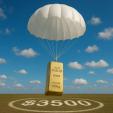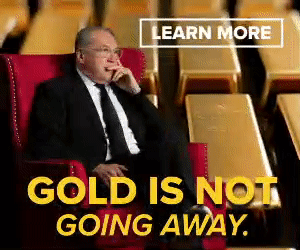Wall Street split between optimism and the fence, Main Street bullish on gold once again as political machinations roil markets
NEW YORK (July 18) Gold prices largely tuned out tariff talk this week as the threat of political interference in the Federal Reserve kept market participants riveted to their screens.
Spot gold kicked off the week trading at $3,366.60 per ounce, and the yellow metal made multiple early attempts to break above resistance located in the $3,375 area. Once the fourth attempt failed just after 6:00 a.m. EDT Monday morning, gold prices saw their first real dip of the week, falling to near-term support at $3,342 per ounce by 10:30 a.m. The Asian session saw another run-up to $3,365, but the yellow metal triple-topped once again, this time falling all the way down to $3,322 per ounce by noon Eastern on Tuesday.
What followed was the only real sideways trading of the week, as spot prices trended in a relatively narrow channel between $3,320 and $3,342 per ounce.
But rumors that the Trump administration was expecting Federal Reserve chair Jerome Powell to resign saw gold shoot higher once again on Wednesday morning, with spot prices rising from $3,325 per ounce at 10:30 a.m. all the way back to $3,363 just 45 minutes later.
Once Trump and others issued statements reassuring markets that no imminent shake-up was in the cards for the central bank, gold prices slid steadily lower, ultimately bottoming out at the weekly low of $3,312 per ounce at 8:30 a.m. EDT on Thursday morning. But this level proved attractive to bulls, and spot gold was trading above $3,340 by early afternoon.
The yellow metal made one final push higher during the Asian and European sessions on Friday, eventually topping out just above $3,360 per ounce at 8:30 a.m. Eastern. But North American traders received positive data on inflation expectations later in the morning, and gold prices rode a slow slide lower to the $3,350 area into the weekend.

The latest Kitco News Weekly Gold Survey showed industry experts still divided between bullish and neutral on gold’s near-term prospects, while retail traders returned to their customary bullish bias.
“Up,” said Darin Newsom, senior market analyst at Barchart.com. “Nothing has changed. Certain uncertainty still reigns. Meanwhile, the next Federal Open Market Committee meeting grows larger on the horizon with the Fed fund futures forward curve showing no change in the Fed fund rate until at least the October meeting.”
Analysts at Commerzbank said the gold price appears to be running out of steam. “Although the US dollar fell to its weakest level against the euro in four years at the beginning of the month, gold more or less remained at levels just below USD 3,400 per troy ounce,” they noted. “The recent sharp price increases of other precious metals, such as silver, platinum, and palladium, also indicate that investors see little upside potential in the metal, which has otherwise been so popular this year, and are instead looking for alternatives.”
“Higher,” said Rich Checkan, president and COO of Asset Strategies International. “Concern over the fate of the Federal Reserve Chairman, saber-rattling in the Middle East, Far East, and Europe, and a clearly established U.S. dollar weakening trend all favor higher prices for gold.”
“Up,” said James Stanley, senior market strategist at Forex.com. “Gold had a big response to trendline support this week, so bulls still aren’t out of it yet, in my opinion. There has been stalling around 3350/3362, but I still have no evidence that sellers are able to take over for anything more than short-term pullbacks.”
“With FOMC the week after next, I think we’ll see markets setting up for a Fed laying groundwork for a September cut,” Stanley predicted.
Adrian Day, president of Adrian Day Asset Management, said he thinks the Federal Reserve will continue to resist calls for rate cuts.
“I still think that Jerome Powell in particular is reluctant to cut rates,” he said. “I think there are three main reasons for that.”
“One is inflation is still not under control,” Day said. “I know they look at the inflation expectations, not just on the actual numbers; they've put a lot of weight on the expectations. But I think if you were an inflation hawk, you could make a case that inflation is still not under control. I mean, if you look at a six-month basis, it's still above where we were pre-COVID. It's still above the Fed's target. And I think Powell is very focused on that, particularly since he seems to think that the economy and the labor market are very strong. I disagree with him on that, but if you think you don't have much of a risk at the moment in the labor market, you can justify keeping rates higher.”
Day also believes Powell will hold off because of genuine concerns over the degree of economic uncertainty.
“Obviously there's uncertainty with the tariffs, but just a lot of uncertainty on the economic and monetary front,” he said. “And if you have uncertainty, doing nothing or just staying where you are makes more sense than going in one direction or the other.”
Day said that while he understands Powell’s concerns over tariffs, he doesn’t agree with them, because tariffs are more likely to depress growth than increase inflation. “Both theoretically and empirically, you couldn't argue that tariffs are inflationary, and I think that's just an excuse to be honest,” he said. “But it’s a force outside of their control, and it puts the blame on someone else. But I do think the uncertainty is a very valid argument.”
“And then the third thing is, let's face it, if you are any kind of man with dignity, and you've got the President tweeting that you are a moron, you’re stupid, you need to cut rates, what's the natural response? The natural response is not to do what the guy’s telling you to do.”
But beyond the personal, Day said Powell’s resistance to Trump’s pressure tactics cut to the core of his professional responsibility to the Federal Reserve system.
“I think that's the big issue,” he said. “It's not just the dignity, it's to maintain the appearance of independence, because he is incredibly focused on the Fed being independent.”
As for the impact all of this has on gold, Day said it’s only supportive of the current high price range – and if the real economy weakens as he expects – it will bring a whole new cohort of buyers into the market.
“I don't think we're going to see a break to the downside,” he said. “That seems to be increasingly off the table. A confluence of events that are all possible, not outlandish – I'm not talking about the US government fixing the budget deficit – but if we got half a dozen trade deals actually signed, if there was any kind of progress in the Middle East – Saudi Arabia's talking about joining the Abraham Accords – if we had two or three things come together and then on top of that, economic news was reasonably positive, and Powell saying ‘No need to cut,’ all of that together – and a dollar rally, of course – all of those things aren't impossible. If we got all of those at the same time, I think we could see a pullback in gold.”
“But fundamentally it looks as though gold is amazingly resilient on the downside, which simply suggests that there's a lot of buying on the sidelines,” he added. “And all of this is without even what I think of as the normal traditional economic drivers [for a gold rally]: a slowing economy, lower interest rates, higher inflation, positive real interest rates in the economy in North America, particularly the U.S., and then the Fed is forced to cut.”
“I think that's going to be very bullish for gold. And we haven't seen that source of buying yet.”
This week, 15 analysts participated in the Kitco News Gold Survey, with only one Wall Street expert maintaining their bearish position once again. Eight experts, or 53%, still expect to see gold prices rise during the week ahead, while one analyst, representing 7%, predicted a price decline. The remaining six analysts, or 40%, saw the yellow metal trending sideways next week.
Meanwhile, 223 votes were cast in Kitco’s online poll, with Main Street investors returning to their bullish majority after one week of doubt. 138 retail traders, or 62%, looked for gold prices to rise next week, while 38, or 17%, expected the yellow metal to lose value. The remaining 47 investors, or 21%, saw prices continuing to consolidate during the week ahead.

Next week’s economic news docket will be dominated by the European Central Bank’s interest rate decision, with manufacturing and housing data also due for release.
On Tuesday, Federal Reserve Chair Jerome Powell will present opening remarks at an event in Washington, D.C. While it’s unlikely, market participants will be on the edge of their seats to see if he addresses President Trump’s recent attacks.
Wednesday will see the release of U.S. Existing Home Sales for June, followed by Thursday’s ECB monetary policy decision, flash S&P PMI data, U.S. weekly jobless claims, and New Home Sales. The final data of note will be the Friday morning release of U.S. Durable Goods for June.
“I like gold higher in the coming days,” said Marc Chandler, managing director at Bannockburn Global Forex. “I suspect the backing up of short-term US rates and USD’s upside correction is over or nearly so. The yellow metal has not traded above $3400 in around a month, and a push above there would confirm my suspicions.”
“Watch the trendline drawn off the record high (~$3500) and the June high (~$3451), which comes in near $3430 at the start of the new week and slips to around $3425 at the end of the week,” he added.
Sean Lusk, co-director of commercial hedging at Walsh Trading, said the Trump-Powell tensions are the main thing keeping gold prices at their current highs.
“This market was ready to have a correction, and I think the rumors about the Fed chair are enough to keep the gold market bid here for a second amid the uncertainty,” he said. “There's really nothing geopolitically that's driving gold higher as I see it, because if there were, crude would be a lot higher, and it's not.”
Lusk said the Fed won’t cut at the July meeting, and he doesn’t think they’re in any hurry to cut afterward, either.
“I personally don't think they're going to do anything with rates,” Lusk said. “The President's really been aggressive in trying to get [Powell] to step down, and he's not going to. Now they're bringing this stuff about spending too much money to redo the Federal Reserve building, looking for any kind of reason to get him to resign. But [Trump] also said he is going to let him finish out his term, which is another 10 months. What do you get? Who knows? But I think we'll get some more clarity on that issue, and maybe we'll get prices to step back here.”
Meanwhile, Lusk pointed out that Trump has placed new tariffs on metal-producing countries like South Africa, along with his 50% tariff on all copper imports.
“That's going to hold the whole complex up here,” he said. “That’s why the market just doesn't want to turn around. It looked like earlier in the week it was going to, and then this Powell stuff – the rumors about him being fired – turned it right around. Now you have the EU announcing some sanctions on Russian energy overnight, which was seen as supportive for metals from a safe haven standpoint. But really, they can do any sanctions they want; they've meant nothing so far, so that whole bid is just a sideshow.”
As for gold’s price drivers in the short and medium term, Lusk said it’s difficult to make the case that the yellow metal should go higher.
“The last two and a half years it's been central bank buying,” he said. “But do they have to continue to buy when their stock markets are overperforming? You wouldn't think so, but we'll see what happens. We had a brief dip down to $3,250, and it didn't stay there. $3,290 was the next level down the other day. Come on, in November we were at $2,541 and at year-end we were at $2,641.”
“I just don't know what the appeal's going to be up here, because as the tariffs get priced in, the market seems comfortable with it,” Lusk added. “The equities seem comfortable with it, the bond market seems comfortable with it, for the most part. The big banks are buying, they don't want to chase, and there's no reason for that with their [equity] indices.”
“I just feel that there isn't the need to chase this thing higher, given their situations and their own stock markets,” he said. “I know that's not everything, but it's a big thing.”
Analysts at CPM group issued a buy recommendation for gold on Friday, with an initial target price of $3,425 by August 5.
“CPM’s most recent Gold Trade Recommendation was a Buy recommendation on 10 July,” they said. “Gold was $3,328.50 and CPM projected a rise in prices with an initial target of $3,375. We added that ‘A stronger increase, to CPM’s past $3,425 ultra short-term upside target, is possible, although it may not happen yet in July.’”
“Gold exceeded $3,375 the next day, touching $3,381.60,” the analysts noted. “It has traded between $3,326.10 and $3,389.30 in the ensuing six trading days. Gold prices may continue to trade between $3,320 and $3,400 over the next several trading days, but CPM anticipates a move above $3,400 back toward $3,425 or higher between now and the middle of August.”
“Up,” said Michael Moor, founder of Moor Analytics. “In a Higher time frame: I cautioned on 8/16/18 the break above $1,179.7-$1,183. warned of renewed strength. We have seen $2,326.2. The solid trade above 21484 projected this upward $954 (+). We attained $1,361.5. These are OFF HOLD. On a Medium time frame: The break above 31482 warned of strength for days—we rallied $328.1. The trade above 32214 projects this upward $100 (+)—we rallied $254.9. The above are OFF HOLD.”
“On a Lower time frame: On 7/1 we left a bullish reversal below. The trade above 33248 (-5 tics per/hour) projects this upward $50 (+)—we attained $64.5,” Moor said. “The trade above 33455 (-3 tics per/hour) projects this up $40 minimum, $110 (+) maximum—we have attained $43.8. Decent trade above 33805 (-.6 of a tic per/hour) will project this upward $65 minimum, $150 (+) maximum. Decent trade below 33215 (+2 tics per/hour) will project this downward $65 (+).”
And Kitco senior analyst Jim Wyckoff expects gold prices to continue consolidating next week. “Sideways and choppy grind will continue amid the summertime doldrums and a lack of market-moving news.”
At the time of writing, spot gold last traded at $3,350.09 per ounce for a gain of 0.33% on the day and 0.73% on the week.
KitcoNews










